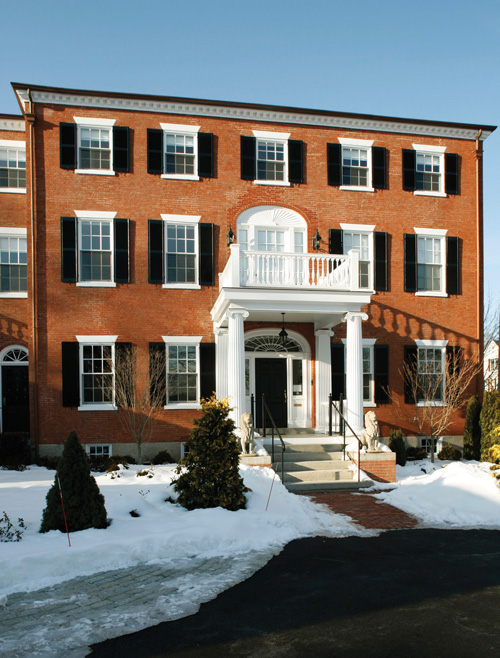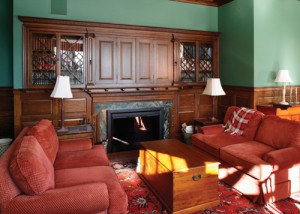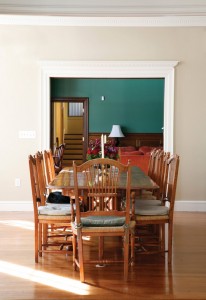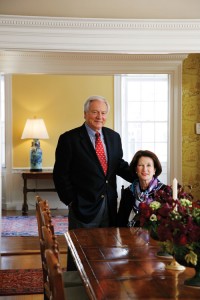Drilling 500-foot wells in the front yard isn’t just good for the environment, it’s old-fashioned yankee common sense for Neil and Martha Chayet.
Scotch-taped to the glass beside the front door of martha and Neil Chayet’s immaculately restored Federal-period house at 26 Winter Street, Salem, just off the Salem Common, is a small unassuming piece of paper. Beneath the seal of the US Green Building Council, the note reads: “The Joseph Story House, Salem, MA, is recognized as a building participating in the LEED for Homes Pilot demonstration, with a commitment to actively promoting the transformation of the mainstream home building industry toward more sustainable practices.”
The message is short, but the story behind it is long, costly, complex, and not without drama. There’s Neil’s historic model train set that caught on fire, for starters, which precipitated the Chayets’ move from Manchester to Salem in 2005. There’s the fact that the Story House, as the circa 1811 property is known, had been on the market for years, but at 9,000 square feet and on the National Register of Historic Landmarks, it wasn’t exactly your garden-variety fixer-upper. And, most critically, there’s the fact that Neil and Martha Chayet like to look at houses two ways: with a deep respect for historically accurate preservation and with a passionate commitment to green building practices.
 The Joseph Story House, Salem, MA.” />
The Joseph Story House, Salem, MA.” />
The Joseph Story House, Salem, MA.
If all goes according to plan, within the next few months, the Chayets’ dual aims will be realized when their home receives Leadership in Energy and Environmental Design (LEED) Silver certification, which is the green building movement’s version of the Good Housekeeping Seal of Approval. The Story House has specific features-a stateof- the-art geothermal heating and cooling system, closed cell insulation that prevents drafts, and glass doors over its fireplaces for improved air quality, among others-that make its Home Energy Rating System 48 percent better than code, notes Matt Root, Green Building Manager for Conservation Services Group, Westborough, and a LEED home inspector. As far as Root and the Chayets know, the Story House would be the first home to be certified on the National Register of Historic Landmarks.
Throughout the process which took two years, the Chayets sought to dispel the notion that an historically accurate house and green renovation is an oxymoron. “We take the energy problems of the planet very seriously,” says Neil. Martha considers preserving historic homes the ultimate form of recycling. “Saving historic homes is very green rather than razing them and putting them in a landfill,” she says.
The historic piece comes naturally to both Chayets. Neil, the longtime host of the CBS radio program, “Looking at the Law,” successfully lobbied Congress for tax credits for environmentally-minded homeowners, covering, among other things, solar heating, home windmills, and in the Chayets’ case, a $100,000 geothermal heating and cooling system, whose wells are underground in their front yard. The excavators (Geothermal HVAC, Merrimack, NH) unexpectedly struck brackish salt water while they were digging in the front yard. “They basically hit Salem Harbor,” Chayet quips. Undeterred, he supported the team’s alternate (and not inexpensive) solution to drill seven, shallower 500-foot wells as opposed to a single deeper one through granite ledge. “It’s a wonderour neighbors have forgiven us for all of that racket,” Chayet says. Today he proudly describes his unique front yard. “We have horizontal piping that spans 3,500 feet of earth, which naturally heats the solution to 55 degrees and enables us to heat and cool the house without any oil or gas, resulting in a zero carbon footprint,” he boasts.
 Martha, a trustee for the Peabody Essex Museum, and former finance chairman for Mitt Romney and Bill Weld, is wading through the extensive paperwork involved in the LEED certification. Her involvement with the PEM also gave her credibility when she spent months in meetings with the Salem Historic Commission to gain approval for the Chayets’ ambitious plans. In addition to replacing all of the windows and installing an elevator, the scope of the work included tearing down a garage that was unoriginal to the property; adding a new brick carriage house wing containing a kitchen, garage, loft media room, and pergola; and renovating two apartments and a courtyard that open onto the Oliver Street side of the house.
Martha, a trustee for the Peabody Essex Museum, and former finance chairman for Mitt Romney and Bill Weld, is wading through the extensive paperwork involved in the LEED certification. Her involvement with the PEM also gave her credibility when she spent months in meetings with the Salem Historic Commission to gain approval for the Chayets’ ambitious plans. In addition to replacing all of the windows and installing an elevator, the scope of the work included tearing down a garage that was unoriginal to the property; adding a new brick carriage house wing containing a kitchen, garage, loft media room, and pergola; and renovating two apartments and a courtyard that open onto the Oliver Street side of the house.
The storied pedigree of the house was a big motivator for both Chayets. Its previous owners include Joseph Story, an associate justice of the Supreme Court; Dr. Amos Johnson, grandfather to the Fidelity Investment Johnsons; and the Vaughan family, whose members made significant contributions to early Antarctic exploration and aviation. The Chayets liken their roles as stewards of the property and strive to honor its legacy in their own entertaining.
Architect Richard Long rose to tricky aesthetic challenges like extending the length of balusters on the prominent front upper balcony six inches in order to meet code without sacrificing any architectural integrity. The Chayets’ contractors, DeIulis Brothers of Lynn, were also chosen for their meticulous care and ability to preserve the home’s history amidst repairs and restoration.
 Painter Steve Berenson of Marblehead exercised a similar fastidious attention to detail. “We spent 11 months on 28 rooms. It was a dream job but not without its challenges,” Berenson says. Berenson and his crew matched 200- year old stain in the oak-paneled family room, scrubbed and restored every single cement rain gutter bracket on the outside of the house, and refinished the triple-tier water fountain in the center of the front yard to resemble its original appearance.
Painter Steve Berenson of Marblehead exercised a similar fastidious attention to detail. “We spent 11 months on 28 rooms. It was a dream job but not without its challenges,” Berenson says. Berenson and his crew matched 200- year old stain in the oak-paneled family room, scrubbed and restored every single cement rain gutter bracket on the outside of the house, and refinished the triple-tier water fountain in the center of the front yard to resemble its original appearance.
By any measure, the Chayets now have a magnificent dwelling to call home. Alongside stunning aesthetics and a storied pedigree, they are proud to instill the house with a green legacy. “Environmental stewardship is the central issue of our time,” says Martha, who was raised on a wheat farm in Oklahoma. “Making our house green is a simple step, but it’s a goal you can actually accomplish that makes you feel like you’re doing your part,” she says.
It’s also a step of which the house’s ancestors would no doubt approve. As Long explains, “One of the nice things about eighteenth and nineteenth century buildings is that our ancestors were very much aware of being green. The Story House was already on its way two hundred years ago. For example, you have vast amounts of windows on the south-facing side of the house, and chimneys on the north. They knew to capitalize on the sun, and to put their backs to the wind, so to speak. Being green is good old-fashioned Yankee common sense.”
Good Ole Yankee Ingenuity:
Opposite, bottom row, middle, Dutch delft tiles with painted harbor scenes from the late 1700s frame the fireplace in Neil Chayet’s study; bottom row, right, a bust of Abraham Lincoln donned with Middlesex Club awards given to Chayet, a former president of the club. This page, top row, left, quarter sawn oak trim and cabinets in the 1901 Von family room; bottom row, left, the kitchen looking into the pantry; middle, the front facade of the home; right, looking through the dining room into the Von room. Previous spread, from left, the Von room; the pantry with Vermont marble countertops and a stainless steel hatch that leads to the recycling bin in the garage; a McIntire-carved chair in the living room.
The Preservation Society:
This page, left, the main staircase leads to the second floor; right, in the study, Hindu deities Ganesha and Buddha share the mantle with a drawing of Joseph Story, the former associate justice of the Supreme Court for whom this house, built in 1811, was named. The Story House is listed with the National Register of Historic Landmarks. Opposite, Neil and Martha Chayet in their dining room. The Chayets moved from Manchester to Salem in 2005 and spent two years upgrading this 9,000 square-foot house so that it can be certified as one of 1,200 homes across the country to receive a LEED silver certification, which is the green version of the Good Housekeeping Seal of Approval. “It became important for us to validate that our historic preservation is green,” Neil says. Upgrades include a $100,000 geothermal heating and cooling system as well as replacing all the windows, building a carriage house wing, and installing an elevator.

